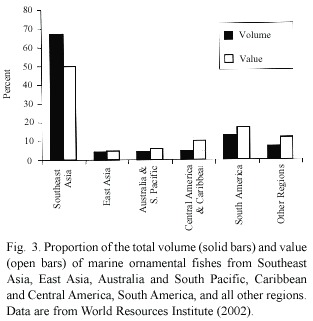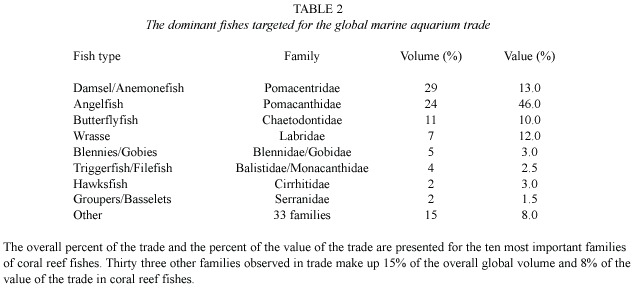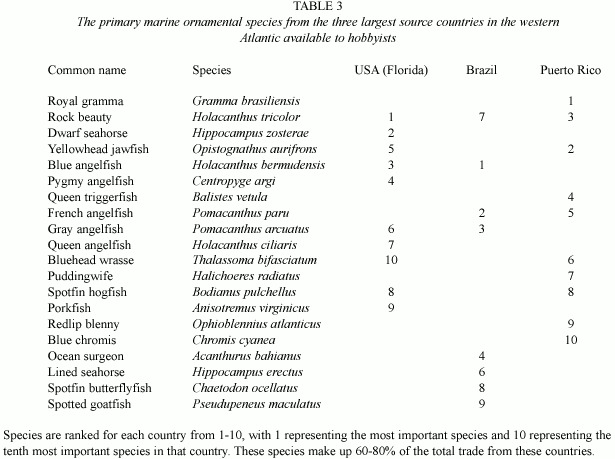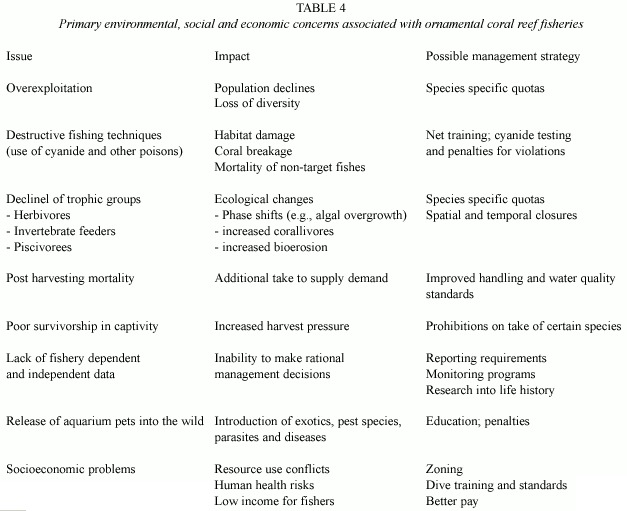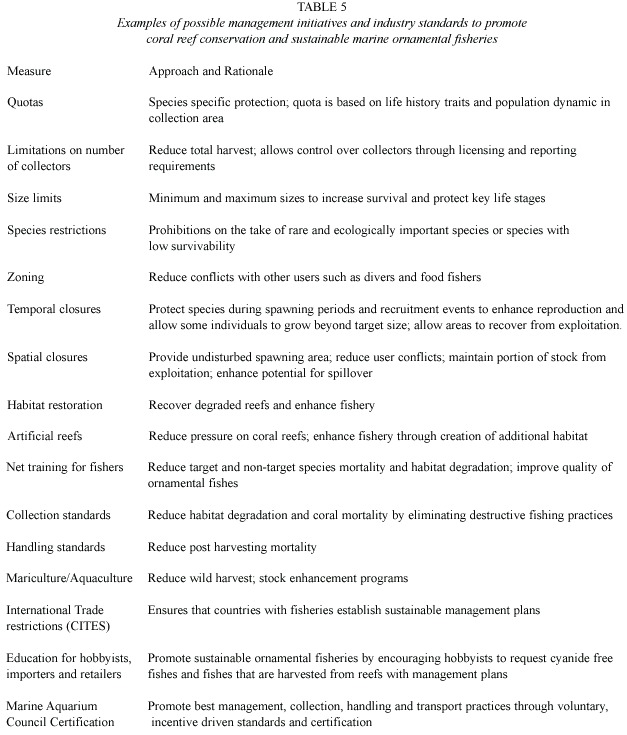Services on Demand
Journal
Article
Indicators
-
 Cited by SciELO
Cited by SciELO -
 Access statistics
Access statistics
Related links
-
 Similars in
SciELO
Similars in
SciELO  uBio
uBio
Share
Revista de Biología Tropical
On-line version ISSN 0034-7744Print version ISSN 0034-7744
Rev. biol. trop vol.53 suppl.1 San José May. 2005
The importance of the marine ornamental reef fish trade in the wider Caribbean
A.W.Bruckner
NOAA Fisheries,Office of Habitat Conservation,1315 East West Highway,Silver Spring,MD 20910, USA; andy.bruckner@noaa.gov
Received 15-I-2004. Corrected 05-IX-2004. Accepted 29-III-2005.
Abstract:The marine ornamental fish trade began in the 1930s in Sri Lanka,spread to Hawaii and the Philippines in the 1950s,and expanded to a multi-million dollar industry in the 1970s with fisheries established throughout the tropical Pacific,Indian and Atlantic Oceans.Currently,45 countries supply global markets an estimated 14-30 million fish annually,with an import value of US$28-44 million.The largest suppliers are Indonesia and the Philippines,followed by Brazil,Maldives,Vietnam,Sri Lanka and Hawaii.In the tropical Western Atlantic,16 countries have export fisheries, including the U.S.(Florida and Puerto Rico).The U.S.is the world s largest buyer,followed by the European Union and Japan.The global trade consists of over 1400 species of reef fishes,of which only about 25 are captive bred on a commercial scale. Damselfish, anemonefish, and angelfish constitute over 50%of the global volume; butterflyfish, wrasses, blennies, gobies, triggerfish, file-fish, hawkfishes,groupers and basselets account for 31%of the trade,and the remaining 16%is represented by 33 families.The most important fishes from the Caribbean are angelfish (six species), seahorses (two species), royal gramma, jawfish,queen triggerfish,redlip blenny,puddingwife,bluehead wrasse,and blue chromis.The Caribbean currently supplies a small percentage of the global trade in marine ornamental species,but ornamental fisheries in this region represent important emerging industries.It is critical that effective ornamental fishery management plans and regulations are developed and enforced,and fishery-dependent and fishery-independent data are collected and utilized in decision making processes to ensure sustainable ornamental fisheries throughout the region.
Key words:Aquarium fishes,ornamental fisheries,trade in coral reef species,(CITES)Appendix II,international trade.
The ornamental coral reef fishery is a multi-million dollar industry that supports thousands of fishers in developing countries and provides aquarium hobbyists with over 1400 species of marine fishes.This industry began in the 1930s in Sri Lanka as a small export fishery,where collections were made from passenger cargo steamers and fish were stored in tanks on the boat s deck until they reached their final destination (Wood 2001). The trade expanded to Hawaii in 1953 and the Philippines in 1957,as dealers began exporting fish by air.In the 1960s,the Philippines also emerged as the primary source of coral skeletons for curios,with exports destined for beach communities and shell shops in the US,Europe and other locations.By the 1970s,marine ornamental fisheries had become established throughout tropical and subtropical IndoPacific and Atlantic countries (Fig.1).
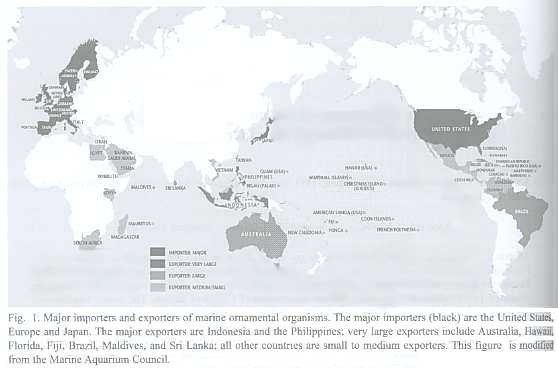
Exports of marine ornamentals continued to increase throughout the 1980s.Dealers in the Indo-Pacific also began supplying live coral in the mid 1980s.Since 1987,the live coral trade has increased by 20-50%each year,with over one million live corals and 1.5 million kg live rock in trade during 2001 (Bruckner 2003). In addition,45 countries exported an estimated 14-30 million ornamental marine fishes annually during the 1990s,at a wholesale (import) value of up to US $44 million and a retail value approaching US $300 million (Wood 2001). While marine aquarium displays continue to grow in popularity,an increase in the number of hobbyists establishing and maintaining live invertebrate displays contributed to a slight decline in demand for reef fishes in the late 1990s.
This study was undertaken to determine the importance of the wider Caribbean as a source of marine ornamentals,and to make recommendations on best practices for the harvest and trade in these species at a relatively early stage in the development of the industry in these locations.Although exports of ornamental marine fishes and invertebrates from the Caribbean are minimal when compared to the Indo-Pacific,the ornamental trade in this region increased substantially between 1992 and 2000 (Anonymous 2002).The demand by hobbyists for new taxa,particularly western Atlantic species,suggests that the trade from this region will increase substantially in the upcoming years.With only a few collectors currently operating in this region and the Caribbean accounting for a relatively small proportion of marine ornamentals overall,there is an opportunity to develop this industry in a sustainable manner.
Materials and methods
This study compiled and analyzed available information from U.S.Fish and Wildlife Service and U.S.Customs,the World Resources Institute,UNEPs World Conservation Monitoring Centre,Traffic USA, and other published reports (Miyasaka 1994, Vallejo 1997,Lathrop and Hourigan 1998, Tissot and Hallacher 1999,Anonymous 2002, Anonymous 2003).The most thorough data on trade in marine ornamentals at a genus or species level is available for corals,which are listed on Appendix II of the Convention on the Trade in Endangered Species of Wild Fauna and Flora (CITES).This treaty requires that each importing and exporting country submit an annual report on the total trade at the level of genus or species.There are few data available on the total trade in marine ornamental fishes, on a species by species basis.Detailed information on individual species or source countries for marine fishes are largely unavailable,since only limited recording is done by importing or exporting countries.In exporting countries, fisheries data are often aggregated by weight, making it difficult to determine the quantity of a given species brought to a particular collection point,or the volume of exports in any one year.
Results
Ornamental marine organisms can be divided into four distinct components:stony corals,black coral and precious corals,other live invertebrates such as soft corals,anemones,crustaceans and echinoderms,and fishes. Stony corals are harvested to supply international markets with skeletons for souvenirs and curios;live animals for home and public aquarium displays;manufactured items such as jewelry and carvings;medical uses such as human bone replacement and health food supplements, and as a source of biomedical compounds.A small component of the trade is also for scientific research and to supply captive-breeding facilities.Ornamental fishes are primarily for aquarium displays,with the exception of seahorses and pipefish that are dried for curios and traditional medicines and a few other taxa that are used for curios and various household items (e.g.,lamps made from pufferfish).The only components of the ornamental trade that are currently subjected to international regulations (CITES Appendix II listing)are stony corals,black coral,giant clams, and seahorses.
Invertebrate Trade
There are 65 genera of stony corals that have been reported in the CITES database,of which 98%originate on shallow Indo-Pacific reefs with small volumes from western Atlantic reefs (<1%)and deepwater sources (<2%).The annual volume in 2001 was over one million live corals and 50 000 kg of skeletons (Fig. 2).While maricultured corals (corals propagated from fragments of adult colonies)are increasing in popularity,wild harvested corals currently account for about 97%of all coral in trade. Although the U.S.and most Caribbean nations prohibit the trade in stony corals, western Atlantic taxa occasionally appeared in U.S.markets during the 1990s.For instance, a coral farm (the Oceanographic Institute of Dominica),established in Dominica in 2000, is propagating stony corals and gorgonians collected from Dominica,with the first exports available in the fall of 2003.
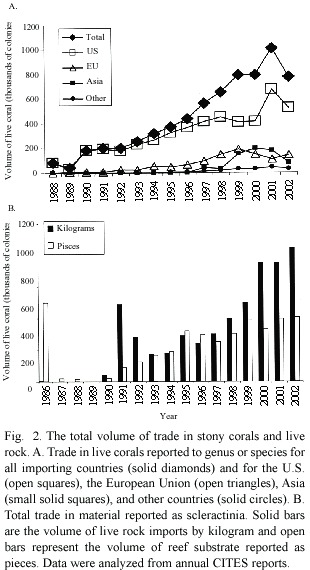
Another component of the trade consists of material reported on CITES permits as "Scleractinia ",which includes live rock,reef substrate,and coral gravel.The trade in live rock increased by over 300%between 1995 and 2002,primarily due to a rapid growth in exports from Fiji;over two million kg live rock and one million pieces of reef substrate were in trade in 2002 (Bruckner 2003).Exports of live rock from Haiti to the U.S.occurred in the past,but this has ceased.In addition,the harvest of wild live rock in Florida was prohibited in the early 1990s,resulting in a shift towards cultured live rock.This consists of limestone base rock harvested from terrestrial deposits in Florida,cultured in Federal waters of the Gulf of Mexico,and supplied to U.S. and European markets.
Black coral (Antipatharia spp.),pink coral (Corallum spp.),and other precious corals are harvested primarily for use in jewelry, with most coming from deeper reefs in the Pacific (Taiwan and Hawaii),Mediterranean, and a small amount of black coral from the Caribbean.The Cayman Islands is the largest source of manufactured black coral in the Caribbean. Hundreds of other genera of invertebrates, including echinoderms,sponges, mollusks and crustaceans are also collected and exported from the Indo-Pacific and western Atlantic,primarily for aquarium displays. There are few available data on the total volume or taxonomic diversity of invertebrates, although live invertebrates are estimated to constitute about 20%of the global trade by value (Wood 2001).
Fish Trade
The largest component of marine ornamental fisheries are fishes,which are currently exported from 45 countries.Indonesia and the Philippines supply approximately 65%of the global trade,and the United States is the largest importer,consuming from 50-60%of all marine ornamental fishes (Fig.1,3).In the U.S.,coral reef fishes are commercially harvested for the aquarium trade primarily from Hawaii,Florida,and Puerto Rico with a small export fishery in Guam and American Samoa;the U.S.Virgin Islands has not issued permits for export of marine ornamental fishes. The largest U.S.fishery is in Hawaii,where approximately 430 000 fishes were collected in 1994 (Miyasaka 1994).Fifteen countries are reported to export reef fishes from the western Atlantic;the largest suppliers are Brazil and Florida,followed by Puerto Rico (160 704 fishes in 1990-1991),with other countries of minor importance (Table 1).
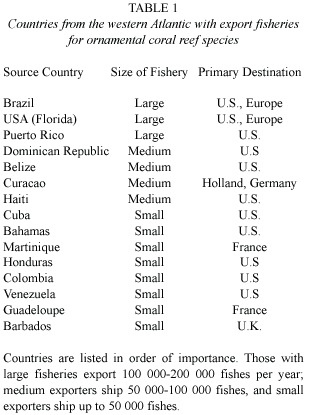
Marine fishes are primarily collected on coral reefs,but associated seagrass beds, mangroves, lagoons,algal flats,rubble fields and other habitats are also important sources. Juveniles are preferred,as they are less costly to transport,they generally survive better due to their small size,and they are typically much more colorful than the adult fish.Males are also preferentially caught over females due to their coloration.Herbivores are the dominant trophic group in the trade,but planktivores (e.g., Chromis spp.),corallivores (Chaetodon spp.), piscivores (Epinephelus spp.),cleaner fishes (Gobiosoma spp.)and other trophic groups are also in demand.
The trade in marine ornamental fishes consists of over 1400 species of marine fishes, of which only about 1%are captive bred (Anonymous 2003,Wabnitz et al.2003).By far the most common fishes in trade are damselfish and anemonefish. These two groups account for almost 33%of the total volume,however most are relatively low value species. Angelfish are the next most important in terms of volume,consisting of about 25%of the total trade.These species are worth much more than most other species,making up nearly 50% of the total import value of ornamental fish. Butterflyfish, wrasses, blennies and gobies, triggerfish,hawkfish and basselets are the other most important taxa (Table 2).
Each country with an ornamental fishery tends to export a fairly small number of species in high volumes and a larger number of species at a low volume,including a few unique species that are very highly valued.These may be endemics,like the banggai cardinalfish (Pterapogon kauderni )which only occurs in a limited area in Indonesia,or deepwater species like Tinker s butterflyfish from Hawaii.There are 20 species that are the primary exports from the three largest exporting countries in the Western Atlantic (Brazil,Florida and Puerto Rico),however,there is very little overlap in the trade in these species from these countries (Table 3).For example,the trade from Puerto Rico from 1990-1991 consisted of 103 species of fishes and 43 invertebrate species,yet the bulk consisted of 10 species (Sadovy 1992).
Environmental Impacts
The potential environmental and biological impacts of the fishery have been recognized for many years,in particular in large exporting countries like Indonesia and the Philippines. These include specific fisheries issues such as the overharvesting and extirpations of key species;coral reef degradation associated with gear impacts and from use of cyanide and other poisons;changes in the ecology of the reefs due to focused collection of specific trophic groups such as herbivores;and loss of biodiversity due to removal of rare species.Addressing these concerns through the development of sustainable management approaches has been hindered by a lack of data and information on the status of the resource,amount of harvest and trade,and a paucity of biological information for most species (Table 4).There are also various other issues and shortcomings that have been identified,such as the potential introduction of non-native species;conflicts with other uses of the resources,such as recreational diving;low income,lack of training and high risk of injury associated with diving practices such as hookah;and harvest and sale of species that are difficult to maintain in captivity or species that are rare or play a key role in ecosystem health.
Reef fishes often experience high post harvesting and transport mortalities.Mortalities typically range from a few to more than 80%as a result of a combination of the use of cyanide to stun fishes,poor capture and handling techniques, inadequate husbandry practices,facilities and transportation,and the inclusion of unsuitable species in the trade (Johannes and Riepen 1995,Wood 2001,Sadovy and Vincent 2002).For instance,a survey of over 300 aquarium fish retailers indicated that mortality levels of fish imported from the Philippines ranged from 30-60% within three days of arrival in the United States (Rubec et al.2001).
Discussion
There are a number of measures that can be applied to ensure that ornamental resources and the habitats they come from are conserved and sustainably managed.These,fall into four main categories:fishery management measures;improved industry standards;development of alternatives to wild harvest;and international trade restrictions.Ways to ensure that collection is maintained at a sustainable level should include a combination of management strategies implemented through an adaptive process,such as a limit on the total number of collectors,quotas developed for each species based on their life history traits and their abundance in the proposed collection area;maximum and minimum sizes for collection;and restrictions on the collection of rare species.Although the trade often targets small juveniles because they are cheaper to transport,very young fish are easily stressed and high losses may occur when they are kept in captivity.In addition,if too much pressure is placed on juveniles insufficient quantity of the stock may be left to reach breeding size. Other protective measures include spatial and temporal closures.Temporary closures can allow recovery from over-use.Also,closure during reproductive seasons or when there is an influx of new recruits may be an effective conservation measure as this could allow some individuals to grow beyond the size at which they are normally collected.No-take marine protected areas are also widely recognized as a strategy to maintain a portion of the resource from exploitation;provide undisturbed spawning grounds;possibly boost recruitment to adjacent fished areas;and they may reduce conflict among other user groups (Table 5).
The industry needs to focus on improving collection techniques to minimize habitat damage and reduce mortality,and improved handling practices and water quality standards especially during transport.Excellent guidelines for best collection,handling and transport practices have been developed as part of the core standards of the Marine Aquarium Council (MAC),an international, non-profit organization that unites ornamental marine animal collectors, exporters, importers, retailers, hobbyists, public aquariums,conservation organizations and government agencies in conservation of coral reefs through voluntary third party certification.For instance,the core standards of MAC provisionally set the allowable limits of marine aquarium organism mortality at the species level at one per cent dead on arrival and one per cent dead after arrival,per species and per shipment,for each link in the chain of custody.A reduction in mortality through the chain of custody translates to reduced harvest pressure to meet international demand,higher quality organisms for the consumer,and larger profits for businesses.
Other organizations,such as the International Marinelife Alliance,have provided training to collectors in the use of nets as a less destructive alternative to cyanide (Rubec et al.2001).Unlike other forms of destructive fishing such as blast fishing that are utilized largely for subsistence fisheries,cyanide fishing is driven entirely by the international trade in live coral reef fishes (Johannes and Riepen 1995).Fishermen squirt cyanide into coral formations to stun and collect their prey,using a crowbar to pry apart the coral heads to reach the fish that retreat into crevices (Barber and Pratt 1998).Cyanide kills many non-target fish along with corals and other reef invertebrates, and a large percentage of the fish that are captured die in transit (Rubec et al.2001).
Other solutions that have been identified, and occasionally implemented,range from the most extreme and contentious (e.g.,a total ban on collection),to ways to improve stocks through habitat restoration, construction of artificial reefs,and establishment of reserves.While these approaches depend on natural recruitment processes,aquaculture and mariculture offers an alternative conservation approach that can reduce demand on wild-harvested fishes by supplying captive bred fishes to the aquarium industry,and it can also be used as a tool to enhance wild fish stocks by supplementing natural recruitment with hatchery produced fry.
One additional tool for species that are in trouble due to international trade are the adoption of international regulations through CITES.CITES is an international treaty with the goal of protecting species of animals and plants by ensuring that commercial demand does not threaten their survival in the wild. Species can be listed on one of three appendices depending on their current status and trade restrictions needed for protection.Currently a number of coral reef species are listed on Appendix II including stony corals,black coral, queen conch and giant clams.The first of the coral reef fishes,all species of seahorses in the genus Hippocampus ,was added to Appendix II of CITES in November 2002 with delayed implementation until May 2004.All Appendix II-listed taxa can still be traded internationally, but shipments must include CITES documentation that verifies that the species were obtained legally and the trade will not threaten their survival in the wild.To ensure non-detriment when trading in a CITES-listed species,countries must have some type of sustainable management plan for any listed species that they plan to export that includes a variety of control measures such as quotas,which are based on the abundance and population dynamics of the species in trade (Armstrong and Crawford 1998,Green and Hendry 1999).
Finally,there is a need for a compilation and analysis of fishery dependent and fishery independent data on marine ornamentals.This includes a quantitative analysis of the amount of harvest and trade on a species by species basis within each collection site,combined with various biological and ecological information and monitoring (e.g.,life history parameters, distribution and abundance,role in the ecosystem,potential threats affecting the species and their habitat)and their suitability for the trade (collection mortality,care requirements, longevity in captivity).It is essential that these data are used in developing management measures and to evaluate the effectiveness of these measures.This is especially critical for some of the highest value species,as these are often those that are the rarest and hardest to find in the wild,and this may create economic incentives adverse to the survival of those species.
By improving collection,handling and transport procedures,the amount of mortality throughout the chain of custody will decline. Better data,adoption of sustainable management plans and improved industry standards may translate to improved survivorship in captivity,thereby reducing the demand for wild harvest and diminishing the negative effects of the marine ornamental trade on the threatened coral reef ecosystems of the world.Through a concerted effort involving fishers,resource managers, other stakeholders and hobbyists, the wider Caribbean can provide a sustainable source of unique marine ornamental species to the aquarium industry.
Acknowledgments
The author is grateful to the NOAA Coral Conservation Program and the National Marine Fisheries Service s Office of Habitat Conservation for support to conduct this research and participate in the AMLC annual meeting.The views expressed within this paper are solely those of the author and do not necessarily represent those of NOAA or the U.S. Government.
Resumen
El comercio de peces marinos ornamentales se inició en la década de 1930 en Sri Lanka y se extendió a Hawai y Las Filipinas en la década de 1950.Posteriormente se convirtió en una industria multimillonaria cuando,en la década de 1970,se establecieron pesquerías a través del Pacífico tropical y los Océanos Índico y Atlántico.Actualmente,45 países suplen los mercados globales con un estimado de 14-30 millones de peces por año,con un valor de US$28- 44 millones.Los mayores exportadores son Indonesia y Filipinas,seguidos por Brasil,Maldivas,Vietnam,Sri Lanka y Hawai.En el Atlántico Occidental tropical,16 países tienen pesquerías de exportación,incluyendo a los Estados Unidos (Florida y Puerto Rico).Estados Unidos es el mayor comprador,seguido de la Unión Europea y Japón. El comercio mundial consiste de más de 1400 especies de peces de arrecife,de las cuales solamente alrededor de 25 son criadas comercialmente.Los peces damiselas, los peces de anémonas y los ángeles,constituyen más del 50%del volumen mundial;mariposas,lábridos,blénidos, góbidos, chanchos, limas, meritos, meros y cabrillas suman el 31%del mercado y el restante 16%está representado por 33 familias.Los peces más importantes del Caribe son los ángeles (seis especies),caballitos de mar (dos especies), bocones,pez chancho reina,blénido de labios rojos, cabeza azul y cromis azul.En la actualidad,el Caribe suple sólo un pequeño porcentaje del mercado mundial de especies ornamentales marinas,sin embargo,las pesquerías ornamentales en esta región representan importantes industrias emergentes.Es crítico que se desarrollen y refuercen planes y regulaciones de manejo efectivos de pesquerías ornamentales y que se recolecte información pesquero-dependiente y pesquero-independiente,que sirva para ser utilizada en los procesos de toma de decisiones,asegurando la sostenibilidad en las pesquerías ornamentales de la región.
Palabras clave:Peces de acuario,pesquería de ornamentales,comercio de especies de arrecifes coralinos,(CITES) Apéndice II,comercio internacional.
References
Anonymous. 2002.The United States consumption of ornamental fish:a preliminary analysis of import data.World Resources Institute,NOAA Final Report.47 p. [ Links ]
Armstrong,J.&J.Crawford.1998.Convention of International Trade in Endangered Species of Wild Fauna and Flora.p.65-67.In M.E Hatziolos,A.J. Hooten &M.Fodor (eds.).Coral reefs:Challenges and opportunities for sustainable management.Proc. of an Associated Event of the Fifth Annual World Bank Conference on Environmentally and Socially Sustainable Development,Oct.9-11,1997.The World Bank,Washington,DC. [ Links ]
Barber,C.V.&V.R.Pratt.1998.Poison and profits:cyanide fishing in the Indo-Pacific.Environment 40:6-34. [ Links ]
Bruckner,A.W.2003.Sustainable Management Guidelines for Stony Coral Fisheries.p 167-184.In J.Cato &C. Brown (eds.).Marine ornamental species collection, culture and conservation.Blackwell Scientific.Iowa State University Press,Iowa. [ Links ]
Green,E.P.&H.Hendry.1999.Is CITES an effective tool for monitoring trade in corals?Coral Reefs 18: 403-407. [ Links ]
Johannes,R.E.&M.Riepen.1995.Environmental, economic and social implications of the live reef fish trade in Asia and the Western Pacific.Report to the Nature Conservancy and the South Pacific Commission. Bonnet Hill,Tasmania Australia.83 p. [ Links ]
Lathrop,C.&T.Hourigan.1998.The United States and the live reef fish trade:trade-based solutions to cyanide fishing in the Asia-Pacific Region.p. 190-199.In Asia-Pacific Economic Cooperation Marine Resources Conservation Working Group (ed.).Proceedings of the Workshop on the Impacts of Destructive Fishing Practices on the Marine Environment 16-18 December,1997.Agriculture and Fisheries Department,Hong Kong,China. [ Links ]
Miyasaka,A.1994.Status Report:Aquarium Fish Collections.Fiscal Year 1993-94.Division of Aquatic Resources, Department of Land and Natural Resources,State of Hawaii,Honolulu.8 p. [ Links ]
Rubec,P.J.,F.Cruz,V.Pratt,R.Oellers,B.McCullough &F.Lallo.2001.Cyanide-free,net-caught fish for the Marine Aquarium Trade .Secretary of the Pacific Community (SPC)Live Reef Fish Info.Bull.7: 28-34. [ Links ]
Sadovy,S.1992.A preliminary assessment of the marine aquarium export trade in Puerto Rico.Proc.7th Int. Coral Reef Symp.,Guam 2:1014-1022. [ Links ]
Sadovy,Y.J.&A.C.J.Vincent.2002.Ecological issues and the trades in live reef fishes.p.391-420.In P.F.Sale (ed.).Coral Reef Fishes:Dynamics and Diversity in a Complex Ecosystem.Academic Press,San Diego, California. [ Links ]
Tissot,B.N.&L.E.Hallacher.1999.Impact of aquarium collectors on reef fishes in Kona,Hawaii.Final report,Department of Land and Natural Resources, State of Hawaii,Honolulu,HI.32 p. [ Links ]
Vallejo,B.1997.Survey and review of the Philippine marine aquarium fishery industry.Sea Wind.11:2-16. [ Links ]
Wabnitz,C,M.Taylor,E.Green &T Razak.2003.From Ocean to Aquarium.UNEP-WCMC,Cambribge, U.K.64 p. [ Links ]
Wood,E.M.2001.Collection of coral reef fish for aquaria: Global trade,conservation issues and management strategies.Marine Conservation Society,Ross-on- Wye,UK.80 p. [ Links ]
Internet references
Anonymous.2003.FishBase.R.Froese &D.Pauly (eds.).(Downloaded:September 24,2003,http//:www.fishbase.org). [ Links ]













